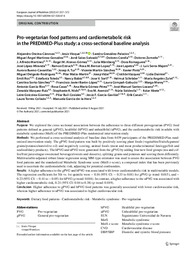Por favor, use este identificador para citar o enlazar este ítem:
https://hdl.handle.net/11000/30764Registro completo de metadatos
| Campo DC | Valor | Lengua/Idioma |
|---|---|---|
| dc.contributor.author | Oncina Canovas, Alejandro | - |
| dc.contributor.author | Vioque, Jesús | - |
| dc.contributor.author | González Palacios, Sandra | - |
| dc.contributor.author | Martínez González, Miguel Ángel | - |
| dc.contributor.author | Salas-Salvadó, Jordi | - |
| dc.contributor.author | Corella, Dolores | - |
| dc.contributor.author | Zomeño, M. Dolores | - |
| dc.contributor.author | Martínez, J. Alfredo | - |
| dc.contributor.author | Alonso-Gómez, Ángel | - |
| dc.contributor.author | Wärnberg, Julia | - |
| dc.contributor.author | Romaguera, Dora | - |
| dc.contributor.author | López-Miranda, José | - |
| dc.contributor.author | Estruch, Ramón | - |
| dc.contributor.author | Bernal-López, Rosa M. | - |
| dc.contributor.author | Lapetra, José | - |
| dc.contributor.author | Serra-Majem, J. Luis | - |
| dc.contributor.author | Bueno Cavanillas, Aurora | - |
| dc.contributor.author | Tur, Josep A. | - |
| dc.contributor.author | Martín-Sánchez, Vicente | - |
| dc.contributor.author | Pintó, Xavier | - |
| dc.contributor.author | Delgado-Rodríguez, Miguel | - |
| dc.contributor.author | Matía-Martín, Pilar | - |
| dc.contributor.author | Vidal, Josep | - |
| dc.contributor.author | Vázquez, Clotilde | - |
| dc.contributor.author | Daimiel, Lidia | - |
| dc.contributor.author | Ros, Emili | - |
| dc.contributor.author | Toledo, Estefanía | - |
| dc.contributor.author | Bablo, Nancy | - |
| dc.contributor.author | Sorli, José V. | - |
| dc.contributor.author | Schöder, Helmut | - |
| dc.contributor.author | Zulet, M. Angeles | - |
| dc.contributor.author | Sorto-Sánchez, Carolina | - |
| dc.contributor.author | Barón López, Francisco Javier | - |
| dc.contributor.author | Compañ Gabucio, Laura M | - |
| dc.contributor.author | Morey, Marga | - |
| dc.contributor.author | García-Ríos, Antonio | - |
| dc.contributor.author | Casas, Rosa | - |
| dc.contributor.author | Gómez Pérez, Ana María | - |
| dc.contributor.author | Santos Lozano, José Manuel | - |
| dc.contributor.author | Vazquez-Ruiz, Zenaida | - |
| dc.contributor.author | Nishi, Stephanie | - |
| dc.contributor.author | Asensio, Eva M. | - |
| dc.contributor.author | Soldevilla, Nuria | - |
| dc.contributor.author | Abete, Itziar | - |
| dc.contributor.author | Goikolea-Güemez, Leire | - |
| dc.contributor.author | Buil-Cosiales, Pilar | - |
| dc.contributor.author | García-Gavilán, Jesús F. | - |
| dc.contributor.author | Canals, Erik | - |
| dc.contributor.author | Torres-Collado, Laura | - |
| dc.contributor.author | Garcia de la Hera, Manuela | - |
| dc.contributor.other | Departamentos de la UMH::Salud Pública, Historia de la Ciencia y Ginecología | es_ES |
| dc.date.accessioned | 2024-01-26T11:33:51Z | - |
| dc.date.available | 2024-01-26T11:33:51Z | - |
| dc.date.created | 2021-08-09 | - |
| dc.identifier.citation | European Journal of Nutrition (2022) 61:357-372 | es_ES |
| dc.identifier.issn | 1436-6207 | - |
| dc.identifier.issn | 1436-6215 | - |
| dc.identifier.uri | https://hdl.handle.net/11000/30764 | - |
| dc.description.abstract | Purpose We explored the cross-sectional association between the adherence to three different provegetarian (PVG) food patterns defined as general (gPVG), healthful (hPVG) and unhealthful (uPVG), and the cardiometabolic risk in adults with metabolic syndrome (MetS) of the PREDIMED-Plus randomized intervention study. Methods We performed a cross-sectional analysis of baseline data from 6439 participants of the PREDIMED-Plus randomized intervention study. The gPVG food pattern was built by positively scoring plant foods (vegetables/fruits/legumes/ grains/potatoes/nuts/olive oil) and negatively scoring, animal foods (meat and meat products/animal fats/eggs/fish and seafood/dairy products). The hPVG and uPVG were generated from the gPVG by adding four new food groups (tea and coffee/ fruit juices/sugar-sweetened everages/sweets and desserts), splitting grains and potatoes and scoring them differently. Multivariable-adjusted robust linear regression using MM-type estimator was used to assess the association between PVG food patterns and the standardized Metabolic Syndrome score (MetS z-score), a composed index that has been previously used to ascertain the cardiometabolic risk, adjusting for potential confounders. Results A higher adherence to the gPVG and hPVG was associated with lower cardiometabolic risk in multivariable models. The regression coefficients for 5th vs. 1st quintile were − 0.16 (95% CI: − 0.33 to 0.01) for gPVG (p trend: 0.015), and − 0.23 (95% CI: − 0.41 to − 0.05) for hPVG (p trend: 0.016). In contrast, a higher adherence to the uPVG was associated with higher cardiometabolic risk, 0.21 (95% CI: 0.04 to 0.38) (p trend: 0.019). Conclusion Higher adherence to gPVG and hPVG food patterns was generally associated with lower cardiovascular risk, whereas higher adherence to uPVG was associated to higher cardiovascular risk. | es_ES |
| dc.format | application/pdf | es_ES |
| dc.format.extent | 16 | es_ES |
| dc.language.iso | eng | es_ES |
| dc.publisher | Springer | es_ES |
| dc.rights | info:eu-repo/semantics/openAccess | es_ES |
| dc.rights | Attribution-NonCommercial-NoDerivatives 4.0 Internacional | * |
| dc.rights.uri | http://creativecommons.org/licenses/by-nc-nd/4.0/ | * |
| dc.subject | Dietary food patterns | es_ES |
| dc.subject | Cardiometabolic risk | es_ES |
| dc.subject | Metabolic syndrome | es_ES |
| dc.subject | Pro-vegetarian | es_ES |
| dc.title | Pro‑vegetarian food patterns and cardiometabolic risk in the PREDIMED‑Plus study: a cross‑sectional baseline analysis | es_ES |
| dc.type | info:eu-repo/semantics/article | es_ES |
| dc.relation.publisherversion | https://doi.org/10.1007/s00394-021-02647-4 | es_ES |

Ver/Abrir:
Pro vegetarian food patterns and cardiometabolic risk in the predimed plus study a cross sectional baseline analysis.pdf
787,4 kB
Adobe PDF
Compartir:
 La licencia se describe como: Atribución-NonComercial-NoDerivada 4.0 Internacional.
La licencia se describe como: Atribución-NonComercial-NoDerivada 4.0 Internacional.
.png)